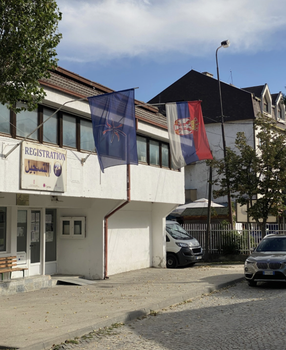
Southern Balkan invisible spatialities, Serbia borderscapes, Bosnia-Herzegovina de/re-routings
By Dragan Umek

From September 25 to October 6, 2023, Claudio Minca and I travelled to several key sites across the “Balkan Route.” This “Balkan road trip” aimed to introduce and discuss the project with key actors and to improve our understanding of diverse contexts along the route, as a foundation for further research. We began our visits in Belgrade, Serbia, and continued with stops in North Macedonia, Albania, Greece, Montenegro, and Bosnia and Herzegovina, before returning to Trieste, Italy.
In Belgrade, we visited the offices of local NGOs to mutually introduce our work, and learn about the current migration situation in Serbia, broadly.
The following day we drove south and visited the Reception Center in Preševo, Serbia, before continuing to Skopje.
In Skopje we met with Viki Mladenova, who arranged and accompanied our visits across North Macedonia over the following three days. Our meetings in North Macedonia included the Italian Ambassador, the director of the Ioannina-based NGO Second Tree, the UNHCR Office, and the Centre for Asylum Seekers in Skopje. During visits to the Vinojug Transit Centre on the Southern border, to the Tabanovce Transit Centre on the northern border, we were able to meet with camp managers, NGO workers, and security personnel.
The following days were characterized by long drives from North Macedonia to Albania and Greece, passing through the Kapshtice border and returning to Albania through the Kakavije crossing. In this way we sought to roughly trace a small section of the route in the Epirus region, touching on several reception centers that were still active or recently closed.
On October 3rd we arrived in Tirana where we conducted a series of institutional meetings, including meeting with the Italian Ambassador, and the IOM delegation in Albania. On that occasion we learned more about the regional geopolitical framework of migrations and the role played by of the three Transition Centres (Kapshtice, Kakavije and Qafë Botë) and the two Asylum Centres (Gjirokastër and Tirana) currently operating in Albania, before continuing our travels onwards to Podgorica, Montenegro.
As in the other regional capitals, our work in Podgorica focused on institutional meetings, including the Italian Ambassador and the EU Delegation in Montengro. Our final day of the trip brought us to Sarajevo. Together with Yolanda Weima we visited and had meetings at at the IOM headquartes in Sarajevo and at the Italian Embassy.
On the return trip to Trieste, we crossed yet another nodal point of the Balkan Route, specifically the border crossing near Gradiška on the Sava River, one of the main crossing points used by migrants from Bosnia to Croatia.